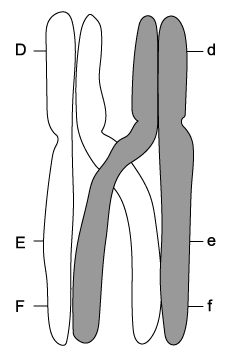a)
Outline the purpose of meiosis in living organisms.
[2 marks]
Assess your score
View Answer
b)
The table below contains a series of statements about meiosis in human cells.
Statement True / False
2 daughter cells are produced
False
Homologous pairs of chromosomes are separated
Daughter cells have the full number of chromosomes
Two cycles of division take place
DNA replication occurs before the process begins
Complete the table by indicating whether each statement is true or false . The first row has been completed for you.
[2 marks]
Assess your score
View Answer
c)
The diagram below shows a simplified life cycle of a fern plant.
Identify the types of cell division taking place at the positions marked A and B .
[2 marks]
Assess your score
View Answer
d)
Identify the process taking place at the position marked C in the diagram in part c).
[1 mark]
Assess your score
View Answer
Next Question
a)
The process of meiosis was discovered in the late 1800s.
i)
State one challenge that would have been faced by the scientists studying cell division at this time.
[1 mark]
ii)
Describe an observation that would have led to the discovery of meiosis.
[1 mark]
Assess your score
View Answer
b)
The image below shows two chromosomes.
i)
Identify the structures labelled X and Y .
[2 marks]
ii)
Structures Y and Z are identical.
State why this is the case.
[1 mark]
Assess your score
View Answer
c)
The two chromosomes shown in part b) can be described as homologous chromosomes.
Define the term homologous chromosome .
[2 marks]
Assess your score
View Answer
d)
During meiosis the homologous chromosomes shown in part b) are separated.
Identify the stage of meiosis during which the homologous chromosomes are separated.
[1 mark]
Assess your score
View Answer
Previous Question Next Question
a)
The image below shows a summary of the events during mitosis and meiosis.
Identify the process taking place at the stage marked X .
[1 mark]
Assess your score
View Answer
b)
The stage marked Y on the image in part a) shows a change in the amount of genetic material in the cells.
Describe the events that take place in order for this change to occur.
[2 marks]
Assess your score
View Answer
c)
During division 1 shown in the image in part a) a process known as crossing over takes place.
Outline the events that take place during crossing over.
[2 marks]
Assess your score
View Answer
d)
Crossing over generates genetic variation.
Other than crossing over, identify one other process that generates genetic variation during sexual reproduction.
[1 mark]
Assess your score
View Answer
Previous Question Next Question
a)
The image below shows a pair of chromosomes during meiosis.
i)
Identify the process taking place in the image.
[1 mark]
ii)
Label the image with an X to show the location of the chiasmata.
[1 mark]
Assess your score
View Answer
b)
State the alleles that will be present on each of the grey shaded chromatids at the end of the process shown in part a).
[2 marks]
Assess your score
View Answer
c)
There are many different possible combinations of chromosomes that can be found in the daughter cells produced during meiosis.
Use the formula 2n to calculate the number of possible chromosome combinations that can be generated in domestic cat gametes. Note that the adult cells of domestic cats contain 38 chromosomes.
[2 marks]
Assess your score
View Answer
d)
Another source of variation during meiosis is a chromosome mutation that results from an event known as chromosome non-disjunction.
i)
State the meaning of the term non-disjunction .
[1 mark]
ii)
Identify one factor that increases the risk of chromosome non-disjunction occurring during meiosis.
[1 mark]
Assess your score
View Answer
Previous Question Next Question
One mark is available for clarity of communication throughout this question.
a)
Draw an annotated diagram of a cell in telophase I. The chromosomes should be clearly defined in your diagram.
[3 marks]
Assess your score
View Answer
b)
Outline the production of a karyogram for the purpose of screening the chromosomes of a developing embryo.
[5 marks]
Assess your score
View Answer
Previous Question



